
364. HiTEC "Systems Management"
- New Hazlett Theater, Pittsburgh, us@
- Friday, January 9, 2009
- Whew! One of the main reasons why I've all-but-stopped writing these descriptions is b/c these events have gotten so complicated that I just don't feel like putting the time & energy into explaining them anymore! BUT, if I don't, who will?
I founded HiTEC (initially called "Sonic Aughts Union") in mid-2008. Our 1st rehearsal was on July 14, 2008. By the time of this gig, we'd had 49 or 50 rehearsals. 16mm footage of the beginning of one of these rehearsals as shot by Tony Balko can be witnessed at: HiTEC021-16mm <http://www.youtube.com/watch?v=e0thj_1lWlA>. It started out intended as a 4-person group to consist of: myself (tENTATIVELY, a cONVENIENCE), Rick Gribenas, Steve Boyle, & Margaret Cox. Steve & Margaret never participated; Rick dropped out immediately due to health problems. Instead, the 1st rehearsal consisted of myself, Rick, & Johan Nystrom - someone I contacted b/c I'd gotten a copy of a CD-R of his & knew him to be a Pittsburgher.
When the Sonic Aughts Union didn't come into being, I decided to try to form an even more ambitious group: an orchestra. Hence HiTEC was born. HiTEC stands for Histrionic Thought Experiment Cooperative. I proceeded to try to recruit something like 53 members - many of whom I didn't know. By the time of this gig there were 22 actual participants - 2 of whom cdn't actually play the gig b/c of schedule conflicts.
HiTEC 'performs' a piece, primarily of my creation, entitled "Systems Management". Other people who've contributed to this are Ben Opie, Johan Nystrom, Kerrith Livengood, Kenny Haney, & Stuart Anderson. The members of the group are called "Systems Managers" & I prefer to say that we "Manage the Systems" (instead of saying, eg, that we "play music"). The language used is deliberately dry & non-'poetic'.
Instead of necessarily 'performing' specified physical actions in unison w/ each other in accordance w/ a specified time-frame, the Systems Managers are given numbered thought experiments to conduct simultaneously - w/ the realization of these being highly open to interpretation. A Wheel-of-Fortune is spun to land on a number from 01-32. That choice is then the indicator to the Thought Experiment to be conducted.
HOWEVER, it's not that simple. In some instances, the Systems Managers can vote for 1 of 2 choices other than the one that the WoF lands on OR various ways of BYPASSING or being a DICTATOR contrary to the main body of Systems, etc..
For this presentation at the New Hazlett, the following 20 Managers were present:
Clockwise w/ the Wheel of Fortune @ 12 O'Clock:
048tENTATIVELY, a cONVENIENCE: piano, SysMan, electronics, percussion, spinner
012Tony Balko: camcorder
013Ben Opie - reeds, electronics
016Kenny Haney: clarinets
013Spat Cannon: upright acoustic bass
013Dani Simmonds: banjo-uke
013Roger Dannenberg: trumpet, flugelhorn, piccolo trumpet
010Missi St Pierre: toy piano w/ effects
013Julian Krishnamurti: electric bass
020Johan Nystrom: extended percussion
010Kerrith Livengood: alto flute
011Ben Harris: violin
016Jonathan Brodsky: monome with mabalhabla software
007Mike Tamburo: hammered dulcimer
014Unfinished Symphonies: electronic keyboard
012Joy: electric guitar w/ nylon strings
013William Wedler: Experiment 1
011Erok: trombone
010Stuart Anderson: laptop
012James Gyre: drums
How many times they had participated in this Systems Management process is indicated by the number preceding their name. Unfortunately, David Bernabo (acoustic guitar, electronics, melodica, percussion, etc) had just had surgery & cdn't attend. Also missing was Hyla Willis (erhu & percussion) who was attending an activist conference in Chicago.
The Systems Managers were arranged in a horse-shoe shape & divided into 4 Affinity Groups. #1 was to the audience's left, followed by #2, followed by James of AG3, followed by the Wheel-of-Fortune in the middle, followed on the audience's right by the rest of Affinity Group 3: tENT + Tony's projection + Ben Opie + Kenny, followed by #4. There was a large screen above the back of the stage area that showed the Systems Management instructions made available by the WoF spin & the voting possibilities (when there were any). To enable this projection, Roger Dannenberg developed "SysMan" software. A screen behind James showed a c/u of the Wheel's number.

(V)Audience members rc'vd a program wch listed the Systems Managers, etc, & provided the following explanation written by me [slightly corrected here]:
"HiTEC (Histrionic Thought Experiment Cooperative) is an independent experimental orchestra founded in July of 2008EV by MAD SCIENTIST / BOOED USICIAN / JACK-OFF-OF-ALL-TRADES / HEADITOR & EARCHIVIST / PROPONENT OF CLASSIFICATION-RESISTANT WHAT-HAVE-YOUS / SPLEENIUS: tENTATIVELY, a cONVENIENCE as an attempt to create a Low Classical alternative to those who worship at the temple of the fictitious & propagandistic "Golden Age" that's often used to justify the "Divine Rights" of cash-flow.
Somewhat like distant cousins to the lineage of Karlheinz Stockhausen's "Aus den Sieben Tagen" intuitive music compositions, FLUXUS prose scores, & the work in general of composer Franz Kamin, HiTEC currently navigates a CONCEPTUAL OBSTACLE COURSE called "Systems Management". Parts of this have been generated by cONVENIENCE, Opie, Nystrom, Livengood, & Haney - all, of course, fleshed out by the considerable talents & quick-wittedness of all the Systems Managers during our COPIOUS REHEARSALS.
Unlike most (M)USICAL projects, the playing of this group revolves around THINKING about particular things while playing in a very open-ended way RATHER THAN necessarily playing specified physical actions.
For example:
30. "Brain-In-A-Vat" (Descartes / tENTATIVELY, a cONVENIENCE): Decide that you're a brain-in-a-vat instead of a brain-in-a-skull & that yr perceptions of what's happening in the current Systems Management session are programmed perceptions rather than 'real' ones. Adapt yr Management to what you then think is the most likely 'reality'.
A Wheel of Fortune is spun, a number is landed on, the number indicates which Thought Experiment is to be conducted by the Systems Managers. The (v)audience sees the experiment instructions projected & is confronted with trying to decipher the puzzle of how the Systems Manager's behavior(s) realize(s) the challenges of the experiment(s).
Why? Imagine that we live in a world where well 'nigh constant pressure is on to close one's mind. While such a closure can make life 'simpler' by disguising limited possibilities as infinite 'freedom of choice' (just don't look behind that Door of Perception!), the 'comfort' that's achieved has psychic virile vines lurking beneath its surface ever-ready to crack the facade wide-open w/ Cognitive Dissonance. As a COGNITIVE DISSIDENT, I embrace the rupture of over-simplification as an ally.
For me, HiTEC & "Systems Management" accomplishes what so many things I love do: it challenges the mind to make quick decisions, to be alert, to REMEMBER - & to KEEP THOSE NEURAL PATHWAYS OPEN. In the meantime, it can be an enormous amt of fun. AND it's deeply rooted in a history of (M)USICAL innovation that I have a heartfelt respect for: everything from Change Ringing to Toy Symphonies to Aleatoric Structured Improvising to Stochastics to the Scratch Orchestra to the Portsmouth Sinfonia to Ensemble Musica Negativa. Finally, it's hoped that if little more than the GREAT CONFUSION results at least there's the hope of thwarting the enemy: Stereotype Projecting.
- tENTATIVELY, a cONVENIENCE - Who Unit?, Pittsburgh, us@ - December, 2008EV"
At the suggestion of New Hazlett Executive Director Sara Radelet, the program also contained a sheet w/ pictures of the Systems Managers + a partial list of their instrumentation on one side w/ 22 "Personality Type" paragraphs on the verso. Sara had proposed that this pre-exisiting material be organized as a game like something that might be on a placemat. Hence the "Match the Systems Managers to their Personality Types" game began.
These Personality Types were created, at my suggestion, by having the Managers pick 4 sentences from any of the abbreviated 16 Meyers-Briggs Personality Types that I'd provided them w/ & by having them add 2 sentences of their own. The results also factor into the Management of a System called "Personality Types (v2)".
Need I say? This brief description barely touchs upon WHAT ACTUALLY HAPPENED. For the beginning of my documentary made from the 8 different camera shots we had of the gig go to: HiTEC 051 pt 1 <http://www.youtube.com/watch?v=tMpa9VMyWmU>. For a high-definition (but soft-focus) excerpt from about 1/3rd of the way thru go to: HiTEC 051 premier @ the New Hazlett Theater <http://www.youtube.com/watch?v=wo2apKl_CCY>.
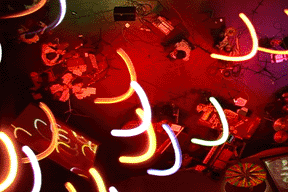
- recollections from tENTATIVELY, a cONVENIENCE
365. Rhythms Lecture
- Rich Pell's "Time & Space" Concept Studio, CMU, Pittsburgh, us@
- Wednesday, February 25, 2009
- Rich Pell invited me to lecture about rhythm to his Carnegie-Mellon University class so I prepared a 6pp script & a DVD-R for the occasion & brought various percussion instruments from my personal collection. I began w/ an explanation of Stockhausen's experiments w/ speeding up rhythms to create pitches - wch lead into my own observations:
"What I get from this is that we have a continuum w/ sound that entails more than just a progression from, say, the inaudible frequencies below 20 cycles per second to the audible ones between 20 & 20,000 cps to inaudible again faster than that. Can an analogy be made between the trio of solids, liquids, & gases & the duo of rhythms & pitch? If so, shd there be a 3rd analogous category of sound? Timbre, perhaps?"
This lead to quoting from David Rothenberg's bk "Thousand Mile Song - Whale Music in a Sea of Sound" & to the idea of the variety of perceptual continuums amongst different creatures. From that I segued into playing a piece by my former collaborator Neil Feather called "Off-Beat-Off" as performed by the Official, April 29, 1992EV, Band That Does Accept Money From Institutions [see entry 160]. Following this vaudeo clip, in my script I had this note to myself:
"ASK QUESTIONS TRYING TO GET THE STUDENTS TO DESCRIBE WHAT THEY JUST WITNESSED - PERHAPS "RHYTHMIC" WILL BE USED - BUT MORE LIKELY "NOISE" WILL BE"
This lead into my discussing the notion of 'dance music' & into one of my favorite subjects: dancing to the sound of a refrigerator - involving the projection of an image of the tape cover of my friend the sound artist Gen Ken Montgomery's "egnekn's fridge" - quoting overtop this from my essay "& the Deadbeat Goes On & On & On..". This talk of 'dance music' introduced a clip from Wes Craven's film "The Serpent and the Rainbow" in wch the dangers of Pavlovian conditioning from entrancement were somewhat addressed. Eventually, the students were given the percussion & were instructed in how to attempt to play the "Off-Beat-Off" - hopefully having a new appreciation for what they may've previously thought of as "random" - now, perhaps, recognizing that skill, discipline, & high levels of organization were actually involved.
- recollections from tENTATIVELY, a cONVENIENCE
366. Ben Harris & Kerrith Livengood's graphic scores
- Johan Nystrom's "why are music series", Monk's, Pittsburgh, us@
- Saturday, March 21, 2009
- Johan Nystrom organized a 4 Saturdays in March series at Monk's called "why are music series - adventures in post-structural pointlessness and olfactory oblivion brought to you by the letters YR". I participated in this, the 3rd, & in the next, the 4th & last. In some ways, this series was an outgrowth of, & side-project in support of, HiTEC (see entry 361). The evening began w/ Kerrith Livengood's "Small Easter Egg Game". The performers (Johan, myself, Missi St Pierre, & Ben Harris) entered from the outside & began searching for small graphic scores that Kerrith had hidden. A text score independent of the graphics specified 3 different ways of playing. We followed #1:
"1. Hide all cards around the room. All players search for them, instrument in hand. When you find a card, stop and play it where you are. Then bring it to the table or stand at the front, placing them in a row in the order they are found. Return to search for other cards. Do not be concerned if there are long silences, or if two or more people find cards and play them at the same time. When all 19 cards are found, all players come together to play the piece from beginning to end, in the order the cards were found."
Further instructions specified:
"All cards represent between 5 - 10 seconds of time. Pitch, rhtyhm, and timbre are all suggested by the shapes, but no paramters are set in stone and colors, shapes, etc. are open to interpretation."
There were something like 18 or 19 cards. The drawings on them were in color. If they were interpreted as if all the separate & parallel lines, eg, were to be followed as suggestive of harmonies then they wd've mostly been beyond the ranges of the recommended "smallest instruments possible". However, given to the openness of interpretation, this wasn't a problem. All of the cards were found & the score was followed accurately enuf. The "Easter Egg" aspect of this was particularly fun & I liked the cleverness of transforming Easter Egg designs into scores.
This was followed by 5 graphic scores of Ben's. Kerrith joined in the above-listed performers (she sat out her own piece - perhaps for the pleasure of witnessing its performance w/o having to otherwise participate). These scores were 8&1/2X11", landscape orientation, black & white. The scores didn't have to be performed in any particular order so we perfoemd them in the order that they'd been emailed to us in. They were, however, created in a specific order. The 1st drawing Ben did was a dense conglomerate of roughly horizontal squiggly lines that overlapped:
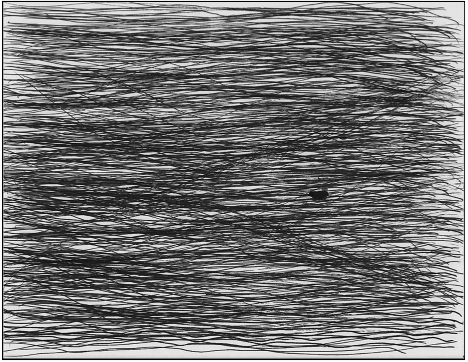
The other 4 drawings were generated by finding other drawings w/in this one's dense field of lines. Each drawing had a significantly different look. As is the convention in graphic notation, the vertical denoted pitch & the horizontal duration. In the score that we performed 1st, there were 5 different horizontally parallel progressions that we interpreted as 5 parts. "Blotches indicate clusters or inharmonic sounds." "medium length" The dense 2nd score was even more open to interpretation. "longer" The 3rd score was basically a horizontally narrower segment of the dense origin score. "Players should oscillate around a specific narrow pitch range." The 4th (again, as performed) was sideways funnel shaped w/ the wide part to the left. "Players should converge on a specific pitch." "shorter" & the last had 5 graphically different clusters.
For both of these I played small instruments such as siren whistle, rattles, & zydeco tie; & vocalized. The vocalizing was the most fun & the most challenging for me since I tried for the 1st time publically to use throat singing technique - wch I felt I pulled off considerably more successfully than I expected to (albeit a little more poorly than I had while rehearsing!). Additionally, I used gestures to represent parts of the notation that I was unable to realize fully w/ sound alone. Kerrith played flute, Missi played toy piano, Ben played violin, & Johan played friction percussion.
From there, a small group of us paraded making mostly quiet sounds to the nearby Casa del Missi & Rich where Missi performed 2 sets of short compositions of hers involving prepared piano & delays.
- recollections from tENTATIVELY, a cONVENIENCE
367. "Triple-S Variety Show" reenactment
- Johan Nystrom's "why are music series", Monk's, Pittsburgh, us@
- Saturday, March 28, 2009
- On January 12, 1995, I had given my 1st performance in Pittsburgh - at the invitation of Orgone Cinema (see entry 195). This had been a "Triple-S Variety Show" concrete mixing event in wch I played 3 synthesizers, one sampler, & one sequencer live at the same time that I mixed together VHS tapes of my movies (mostly ones made for this purpose) while they were being projected. Sometimes the soundtracks of these were also mixed into the overall sound. This gig was a bit overambitious in the sense that I didn't have enuf time to devote myself to either the visuals or the sound individually as much as I'd've like. As such, the live mixing of the visuals, in particular, weren't as strong as I wanted them to be. All of this was originally mixed to VHS tape. In early 2009, I edited this 2 hr VHS document down to a 26 minute DVD-R & decided to 'reenact' the original presentation using samples taken from the materials developed for these "Triple-S Variety Shows" (of wch there were others). I presented it in this context partially so that people who hadn't lived in Pittsburgh in 1995 or who hadn't known me then cd experience that original performance (albeit compacted). I played sampler, sampling mixer, & wave-table synthesizer - structuring my playing largely around traying to make certain types of changes in rough sync w/ edit changes in the vaudeo & allowing specific parts of the prerecorded soundtrack to peep thru from time-to-time.
Following me on the bill was a duet set w/ David Bernabo playing accordian & Mike Tamburo playing a harp-like instrument of his invention called "Crowned Eternal" (or "Crown Eternal"?); then Michael Johnsen played a solo set on his home-made electronics; the evening ended w/ "A Collaboration": 3 guitarists: Mike Tamburo, Josh Beyer, & Tusk Lord).
- on my onesownthoughts YouTube channel here: https://youtu.be/31Idq235Jco
- recollections from tENTATIVELY, a cONVENIENCE
368. HiTE Club Premier w/ "Guitarists Anonymous Withdrawal Aids #7"
- HiTE Club, New Hazlett Theater lobby, Pittsburgh, us@
- Sunday, April 26, 2009
- After the moderate 'success' of the 1st gig of my chamber orchestra, HiTEC, at the New Hazlett Theater on January 9, 2009 (see entry 361), I was invited to host a monthly (M)Usic series in the lobby there. I decided to name this series "HiTE Club - for Histrionic Thought Experimenters & their fellow travelers. This name plays off of HiTEC, Night Club (Nite Club), Hite Report, etc, & has an even more ambiguous branding banner that I hodgepodged rebus-style together very hastily using images found on the net:

The evening began with joy toujours playing "You are beautiful-core" on ukelele & violin (both looped from time to time) & vocals. Self-described as "Music you can play while your four year old is sleeping". I then passed the sombrero "(This is a donation event (no nation but the donation [or is it doughnation?]) & we'll be passing the sombrero around to make sure the hat's big enuf to accommodate the 1st-born & gold bricks.)" Then "Tony Blowad" (David Bernabo: guitar & percussion, Matt Griffin: percussion, Brandon Masterman: baritone & soprano saxes, flute) played a set consisting of responses to fanciful sentences created by them pulled from a jar.
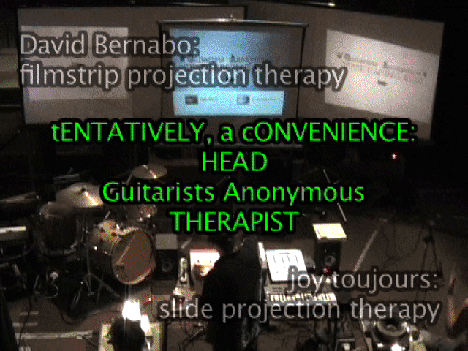
I finished off the nite with the 7th "Guitarists Anonymous Withdrawal Aids" (see entries 314-317, 322, 327, 328, 332) although it cd also be called the 9th one because 2 of the entries referenced parenthetically here were radio shows that I don't include as full-blown "GAWA"s. For this presentation I had joy be the projectionist of the slides (forward only, 1 every 24 seconds please) & David be the projectionist of the filmstrip (much more freeform). This was their therapy. Ok, joy surpirsed me by NOT playing guitar for his thing but he DOES usually play guitar so he still 'needed' the therapy anyway. I was so stressed from the lack of (v)audience (9, c'mon people!, 9!) that I forgot to put on the Guitarists Anonymous 'costume' until after the therapy session started. That was ok even though it was accidental. This was triple projection: filmstrip: left, vaudeo: middle, slides: right. I asked how many people in the audience were guitarists, many raised their hands. I pointed out that if I'd asked how people in the audience were child molestors probably no-one would've raised their hands. This could be used as evidence that guitarists are an even more serious problem because there are so many of them.
- recollections from tENTATIVELY, a cONVENIENCE
369. HiTEC @ The End of Television
- The Nerve Gallery, Pittsburgh, us@
- Friday, June 12, 2009
- At midnight on this date, tv in the us@ changed from analog to digital. Ian Page proposed an event at which he would broadcast on an about-to-be unused & then-unused analog channel vaudeos sent to him from a widely solicited group. See Ian's blog about this @:
http://theendoftelevision.blogspot.com/
In order to inaugurate this auspicious occasion, Ian & I brainstormed an event to be broadcast both over the air & to a wall of something like 23 tvs that Ian erected around his gear at the Nerve Gallery.
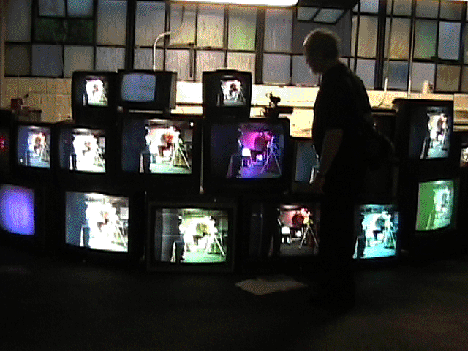
I even went to the trouble of designing & screenprinting a poster for this:
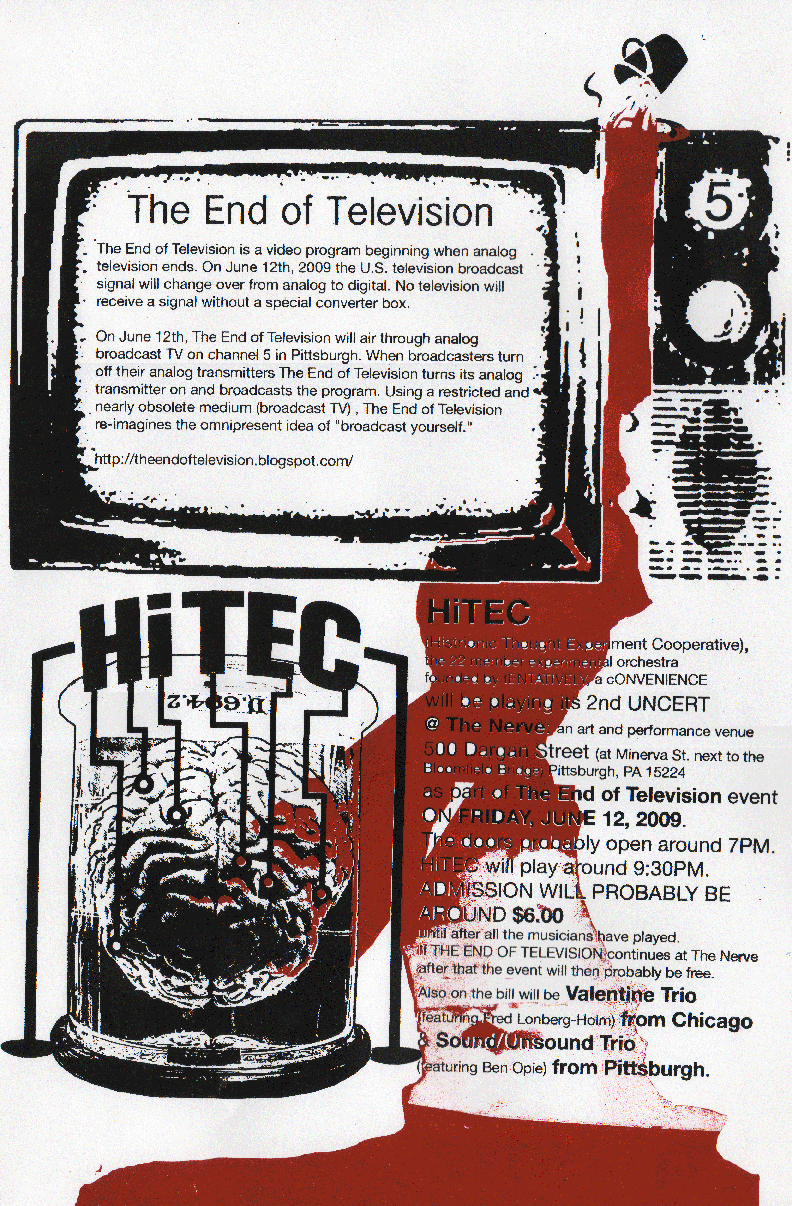
Ben Opie's great jazz group, Sound/Unsound Trio, opened, followed by Fred Lonberg-Holm's also great group from Chicago, Valentine Trio.
Finishing off the bill was the 2nd public appearance of HiTEC (our 59th session). This featured the largest number of HiTEC players to ever be assembled at the same time: 21. The numbers preceding the names listed below indicate how many sessions each Systems Manager had participated in as of this gig. Some new members had been recruited since the New Hazlett premier.
Clockwise from Wheel-of-Fortune:
014Tony Balko: SM camcorder
056tENTATIVELY, a cONVENIENCE: electronics, voice
016Ben Opie: saxes, Thingamagoop
019Kenny Haney: Bb clarinet
014James Gyre: darbouka, drum set, flute
016Spat Cannon: acoustic bass
016Dani Simmonds: ukelele, small banjo, harmonica, darbouka, electronics
016Roger Dannenberg: trumpet, flugelhorn, piccolo trumpet
008Josh Beyer: cello
016Julian Krishnamurti: electric bass
021Johan Nystrom: extended percussion
018Hyla Willis: amplified erhu
014Ben Harris: violin
019Jonathan Brodsky: monome with mabalhabla software
009Mike Tamburo: hammered dulcimer, Crowned Eternal, melodica
012David Bernabo: electric guitar
016William Wedler: Experiment 1
014joy toujours: trombone
019Unfinished Symphonies: electronic keyboard
007Red Bob Jungkunz: drums
007Mike Kasunic: synthesizer, flute, percussion
While the New Hazlett premier was probably our technically finest presentation (thanks to the good conditions & fine staff at the theater), this might've been our most 'high-spirited'. By this time, Johan had moved to Philadelphia & had to come all the way back to Pittsburgh to take part. Everyone seemed enthusiastic about the nature of the event. Added to this, this was the night when the local ice-hockey team, the Pittsburgh Penguins, was playing the final game to win the Stanley Cup. I exploited this by referring to it on the online edit of the gig:
http://www.youtube.com/watch?v=dsncOO-sql0
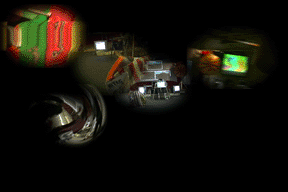
HiTEC began with its usual "Stamping & Clapping" & segued into "Escape Tunnel". From there it Managed "Patterns" simultaneously with an unknown System. "Bypass" led to "Subtlety Olympics" to "Birds". "Yourself" + "MUTE OBSERVER" (a new System developed by Ben Opie & pursued in a particularly inspired way here). "Private Phasing" + "IFF". "Getting It Out of Your" System. "Bypass"->"Debriefing". "Equilibrium" + "Yourself" + "Patterns". "Debriefing". "Persisting Resisting" + "Subtlety Olympics". "Octave Butler". "Bypass"->"Avian Flu". "Avicenna's Floating Systems Manager" + "Octave Butler". "Tele-Communications" + "Cheaper Imitation" + "MUTE OBSERVER". "DICTATOR". "Affinity Groups". "Saboteur (undone)". "Read Players" + "Patterns". "Equilibrium" + "Avicenna's.." + "Red Room" + "MUTE OBSERVER". "Comfort Zone 1" + "Population Control". "Saboteur". "Saboteur" + "Equilibrium" + "Infinite Monkey Theorem". "Saboteur" + "Avicenna's.." + "Getting It Out of Your". Pens Won! ?. "Infinite Monkey Theorem" + "Subtlety Olympics" + "Population Control". "Affinity Groups". Bathroom break. - ie: we ended it by all crowding, one-by-one, into the very small bathroom - much to the confusion of many (including straggling HiTEC Systems Managers).
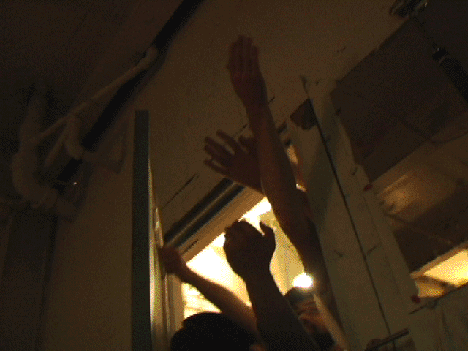
Cameras were wielded, often somewhat participatorily, by myself, Mark
Knobil, Tony Balko, Amanda Bowers, Morgan Cahn, Ian Page, & Alberto
Almarza (this latter using a cell-phone). Thanks are due to those associated
with The Nerve Gallery: Ed-Um Bucholtz, Lauri Mancuso, & Marcus Kim.
- recollections from tENTATIVELY, a cONVENIENCE
370. HiTEC 61 @ The Visionary Arts Festival
- Schenley Plaza, Pittsburgh, us@
- Friday, August 7, 2009
- Alberto Almarza spent a year or so organizing this festival. There were perhaps 50 or more participants who each had a tent in which to display their wares or wherewithals.
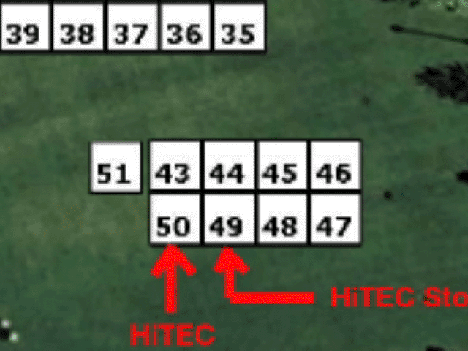
HiTEC (Histrionic Thought Experiment Cooperative) had 2 tents (1 just for storage) & a nightly presentation in the BIG TENT.
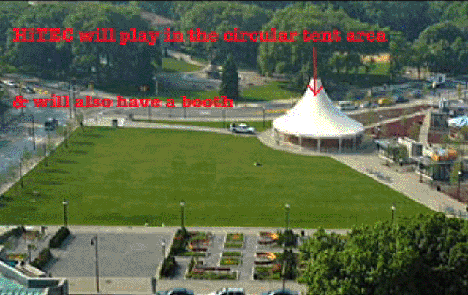
The display tent had a door propped outside that I'd painted with chalkboard paint & 6 monitors on the inside on which were screening simultaneously all of the +/- 60 or so documentaries that I'd made about the project so far. The door/chalkboard listed which documentaries were screening. The Wheel-of-Fortune was there too + a booklet explaining the project in detail & a huge book of press clippings of mine. I sat there most of the day greeting people & explaining. When I wasn't there, the ever-ready & cooperative & sociable HiTEC keyboard player, Unfinished Symphonies, would sit outside busking - playing his indefatigueable selection of songs. A few other HiTEC Systems Managers made cameo appearances - like the very affable drummer, Red Bob Jungkunz. The wonderful Pittsburgh-based artist's books press, Encyclopedia Destructica, had just put out a combination CD/book/DVD with 15 feet of folding-out paper dolls of the HiTEC Systems Managers as part of it & they had their own spacious display tent nearby. The HiTEC tent also displayed the paper dolls.
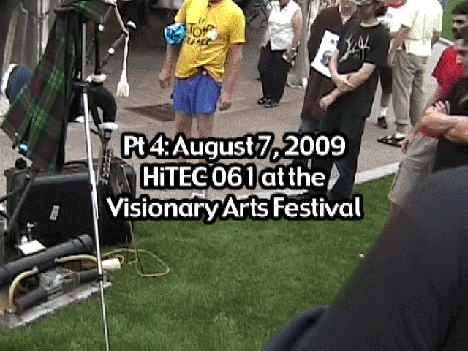
Roger Dannenberg spiced up each night with a presentation by "McBlare" - a robotic, computer-controlled set of bagpipes that he'd codeveloped that played music composed by him, Kenny Haney, & one other composer.
The personnel for this night's Systems Management are listed below. As usual, the numbers preceding the names indicate how many HiTEC sessions this particular Manager had participated in. Johan Nystrom, once again demonstrating what an incredible trooper he is, drove all the way from Philadelphia for this one night.
Audience left to right:
022Johan Nystrom: extended percussion, camera
010Mike Tamburo: hammered dulcimer, clarinet, amplified string & contact mic
016Ben Harris: violin
020Jonathan Brodsky: monome with mabalhabla software
017William Wedler: Experiment 1
021Unfinished Symphonies: electronic keyboard
016joy toujours: trombone
008Mike Kasunic: electronics
058tENTATIVELY, a cONVENIENCE: electronics, percussion
019Hyla Willis: amplified erhu, Jamaican seed pod
015Tony Balko: SM camcorder
018Ben Opie: alto sax, tube w/ reed, small percussion
021Kenny Haney: clarinets
016James Gyre: drum set
017Spat Cannon: acoustic bass
017Dani Simmonds: ukulele, electronics
010Josh Beyer: Baribanjolo
017Roger Dannenberg: McBlare, trumpet, flugelhorn, piccolo trumpet, SysMan
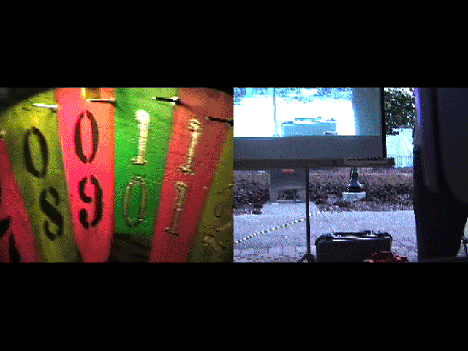
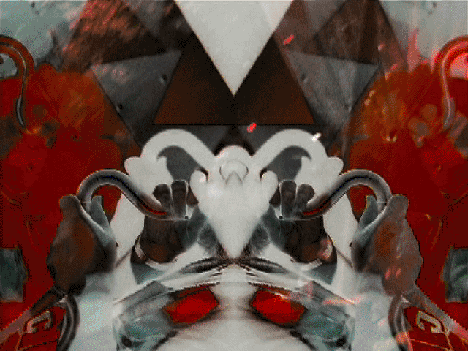
The 1st day of HiTEC @ the Visionary Arts Festival (& days leading up to it):
http://www.youtube.com/watch?v=VlInVCCK4Ro
- recollections from tENTATIVELY, a cONVENIENCE
371. HiTEC 62 @ The Visionary Arts Festival
- Schenley Plaza, Pittsburgh, us@
- Saturday, August 8, 2009
- Alberto Almarza spent a year or so organizing this festival. There were perhaps 50 or more participants who each had a tent in which to display their wares or wherewithals. HiTEC (Histrionic Thought Experiment Cooperative) had 2 tents (1 just for storage) & a nightly presentation in the BIG TENT. The display tent had a door propped outside that I'd painted with chalkboard paint & multiple monitors (6?) on the inside on which were screening simultaneously all of the +/- 60 or so documentaries that I'd made about the project so far. The door/chalkboard listed which documentaries were screening. The Wheel-of-Fortune was there too + a booklet explaining the project in detail & a huge book of press clippings of mine.
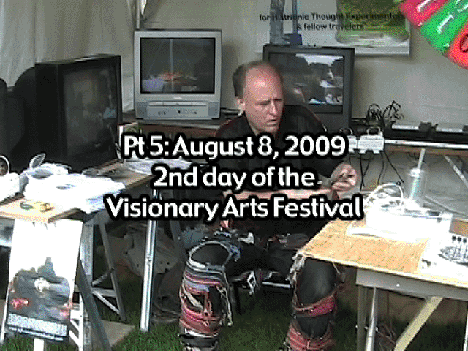
I sat there most of the day greeting people & explaining. When I wasn't there, the ever-ready & cooperative & sociable HiTEC keyboard player, Unfinished Symphonies, would sit outside busking - playing his indefatigueable selection of songs. A few other HiTEC Systems Managers amde cameo appearances - like the very affable drummer, Red Bob Jungkunz. The wonderful Pittsburgh-based artist's books press, Encyclopedia Destructica, had just put out a combination CD/book/DVD with 15 feet of folding-out paper dolls of the HiTEC Systems Managers as part of it & they had their own spacious display tent nearby. The HiTEC tent also displayed the paper dolls.
Roger Dannenberg spiced up each night with a presentation by "McBlare" - a robotic, computer-controlled set of bagpipes that he'd codeveloped that played music composed by him, Kenny Haney, & one other composer.
The personnel for this night's Systems Management are listed below. As usual, the numbers preceding the names indicate how many HiTEC sessions this particular Manager had participated in.
Audience left to right:
011[masked] Kerrith Livengood: electric guitar, etc..
017Ben Harris: violin
021Jonathan Brodsky: monome with mabalhabla software
018William Wedler: Experiment 1
022Unfinished Symphonies: electronic keyboard, tambourine
017joy toujours: violin
009Red Bob Jungkunz: drums
009Mike Kasunic: electric guitar
059tENTATIVELY, a cONVENIENCE: electronics, percussion
020Hyla Willis: amplified erhu, Jamaican seed pod
016Tony Balko: SM camcorder
019Ben Opie: alto sax, tube w/ reed, small percussion
022Kenny Haney: clarinets
018Spat Cannon: acoustic bass [had to leave slightly before the end]
018Dani Simmonds: tenor guitar, electronics
011Josh Beyer: acoustic guitar
018Roger Dannenberg: McBlare, trumpet, flugelhorn, piccolo trumpet, SysMan

This night might've been the most fun sonically DESPITE the fact that there appeared to've been a conspiracy of guitarists. The often unpredictable HiTEC Systems Manager Kerrith Livengood (is she or isn't she a member?) showed up somewhat last-minute wearing a mask & setting up with a guitar rather than her usual flute(s). I wasn't even sure who she was at 1st! Mike Kasunic played guiatr instead of synthesizer, Dani Simmonds played tenor guitar instead of banjo-uke, & Josh Beyer played acoustic guitar instead of cello or Baribanjolo. It was an explicit rule of HiTEC that the playing of GUITAR, the world's most overused & banal instrument, was to be severely discouraged. OBVIOUSLY, the Systems Managers were in revolt!
The 2nd day of HiTEC @ the Visionary Arts Festival:
http://www.youtube.com/watch?v=fR3PRrwnCCs
- recollections from tENTATIVELY, a cONVENIENCE
372. HiTEC 63 @ The Visionary Arts Festival
- Schenley Plaza, Pittsburgh, us@
- Sunday, August 9, 2009
- Alberto Almarza spent a year or so organizing this festival. There were perhaps 50 or more participants who each had a tent in which to display their wares or wherewithals. HiTEC (Histrionic Thought Experiment Cooperative) had 2 tents (1 just for storage) & a nightly presentation in the BIG TENT. The display tent had a door propped outside that I'd painted with chalkboard paint & multiple monitors (6?) on the inside on which were screening simultaneously all of the +/- 60 or so documentaries that I'd made about the project so far. The door/chalkboard listed which documentaries were screening. The Wheel-of-Fortune was there too + a booklet explaining the project in detail & a huge book of press clippings of mine. I sat there most of the day greeting people & explaining. When I wasn't there, the ever-ready & cooperative & sociable HiTEC keyboard player, Unfinished Symphonies, would sit outside busking - playing his indefatigueable selection of songs. A few other HiTEC Systems Managers amde cameo appearances - like the very affable drummer, Red Bob Jungkunz. The wonderful Pittsburgh-based artist's books press, Encyclopedia Destructica, had just put out a combination CD/book/DVD with 15 feet of folding-out paper dolls of the HiTEC Systems Managers as part of it & they had their own spacious display tent nearby. The HiTEC tent also displayed the paper dolls.
Roger Dannenberg spiced up each night with a presentation by "McBlare" - a robotic, computer-controlled set of bagpipes that he'd codeveloped that played music composed by him, Kenny Haney, & one other composer.
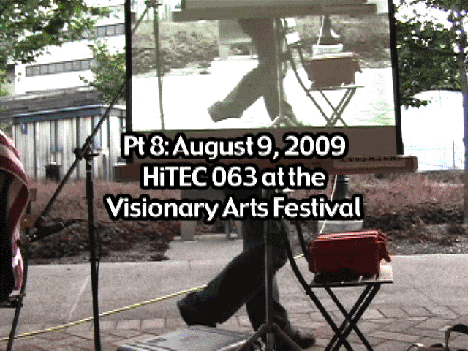
The personnel for this night's Systems Management are listed below. As usual, the numbers preceding the names indicate how many HiTEC sessions this particular Manager had participated in.
Audience left to right:
018Ben Harris: violin
011Mike Tamburo: hammered dulcimer, clarinet, amplified string & contact mic
022Jonathan Brodsky: monome with mabalhabla software
023Unfinished Symphonies: electronic keyboard
018joy toujours: violin, amplified toy stuffed animal
010Red Bob Jungkunz: drums
010Mike Kasunic: electric guitar
060tENTATIVELY, a cONVENIENCE: electronics, percussion
021Hyla Willis: amplified erhu, Jamaican seed pod
017Tony Balko: SM camcorder
020Ben Opie: alto sax, tube w/ reed, small percussion
023Kenny Haney: clarinets
017James Gyre: drum set
019Spat Cannon: acoustic bass
019Roger Dannenberg: McBlare, trumpet, flugelhorn, piccolo trumpet, SysMan
This was the smallest HiTEC group to ever play publically - a sign of the beginning of the end.
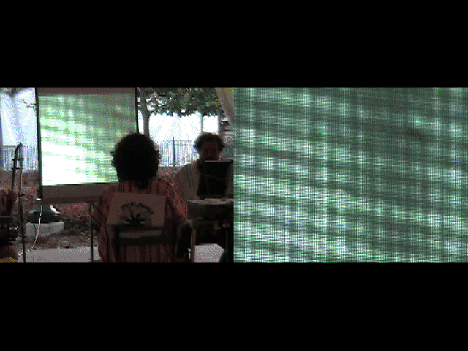
The 3rd & last day of HiTEC @ the Visionary Arts Festival:
http://www.youtube.com/watch?v=YT06HpEcNj0
- recollections from tENTATIVELY, a cONVENIENCE
373. Systems & Processes 1: lecture
- CMU CFA, Pittsburgh, us@
- Wednesday, October 28, 2009
- After the 'success' of the "Public Contexts" lecture that I'd given in Jon Rubin's class the year before I was invited to become a professor at CMU. This came to naught. Jon did invite me back to teach FOUR classes in a row next - an honor he'd never meted out before. For the 1st introductory lecture I had a highly prepared scripted A/V presentation that was interspersed with interaction with the class. Here's the script:
[Since this lecture is in danger of being too dry for the possible attn span of the students, I'm going to try a strategy of sounding a hidden 'noisemaker' or otherwise doing something unexpected & surprising to re-engage people whenever I think the talk's getting too boring - that means that bulb-horns & the like shd be taken - if anyone asks about why I'm doing this, the object used & referred to shd be put in plain sight & students shd be encouraged to use it or anything else in a similar manner if & when they get bored]
[Each A/V component (ie: stills & vaudeo & audio) has :05 of slug preceding & following it & each of the stills is :10 long. Additionally, each component is a separate chapter. As such, to reach each component I shd just advance to the chapter. Each still shd be paused on. The :05 of slug is to catch my attn if I fail to pause on a still & is used to prevent an abrupt accidental moving on to another image section prematurely.]
My interest in systems is synonymous w/ my interest in any imagining of structuring something along broadly inclusive lines. Looking for a definition of "system" online I find many, many uses of the word in many disciplines. Perhaps the most useful for my purposes here are:
"A group of interacting, interrelated, or interdependent elements forming a complex whole.", "An organized set of interrelated ideas or principles.", "A social, economic, or political organizational form.", & " An organized and coordinated method; a procedure." This latter ties into process - the other focus of this class.
An online list of types of systems (slightly modified here) includes: "Anatomical · Artistic · Biological · Complex · Complex adaptive · Conceptual · Database management · Dynamical · Ecological · Economical · Formal · Information · Legal · Living · Measurement · Multi-agent · Nervous · Nonlinear · Operating · Physical · Political · Sensory · Social · & Solar" - I'm not necessarily familiar w/ deeper meanings of some of these &'ve perhaps been mainly concerned w/ something approximately akin to so-called "Systems Art" & Political & Social Systems.
Starting w/ Political & Social Systems I have 2 relevant anecdotes: 1. After screening a short video I'd made w/ post-9/11 commentary, an older man asked me what political system I thought wd 'work'. My answer: "NO political system."; 2. I was talking w/ a Russian ex-patriate in Iowa City & she sd something to me like: "Don't you want more power?" - to wch I replied: "NO, I want other people to have LESS power over me." These ideas are crucial to understanding my own systems imaginings.
[show The New Machiavelli cover here]
Here's a relevant quote from H. G. Wells' novel "The New Machiavelli" from 1911:
"'The present system, I admit, stands condemned. Every present system always has stood condemned in the minds of intelligent men. But where it seems to me you get thin, is just where everybody has been thin, and that's where you come to the remedy.'"
& here's a relevant excerpt from a song entitled "In Your Eyes" on a CD by Alan Barysh & Infiniteye featuring a speech by the Revolutionary Communist Party's Chairman Bob Avakian:
[show Art Between Deliveries cover here & play "Bob Avakian" track here: 1:09]
In other words, any political/social/whatever system will ALWAYS be good for some & bad for others. Here's a short movie that I made editing together various takes on this from a Hollywood spectacle, capitalist anti-communist propaganda, an underground movie, a scientific study, & other sources:
[screen "Capitalism is an Ism" here: 6:40]
The reason for the title "Capitalism is an Ism" is that in the "Ism" cartoon that warns its audience against Isms (mainly targeting communism) there's a transparent avoidance of using the word "capitalism" - wch becomes instead the "capitalistic system". I correct this pathetic propaganda manipulation here.
Perhaps the term that I found most immediately of interest in the previous systems type list was "Complex adaptive systems" wch I found described on Wikipedia (condensed here) as:
"Complex adaptive systems are special cases of complex systems. They are complex in that they are diverse and made up of multiple interconnected elements (and so a part of network science) and adaptive in that they have the capacity to change and learn from experience. The term complex adaptive systems (CAS) was coined at the interdisciplinary Santa Fe Institute (SFI), by John H. Holland, Murray Gell-Mann and others."
"The term complex adaptive systems, or complexity science, is often used to describe the loosely organized academic field that has grown up around the study of such systems. Complexity science is not a single theory- it encompasses more than one theoretical framework and is highly interdisciplinary, seeking the answers to some fundamental questions about living, adaptable, changeable systems.
"Examples of complex adaptive systems include the stock market, social insect and ant colonies, the biosphere and the ecosystem, the brain and the immune system, the cell and the developing embryo, manufacturing businesses and any human social group-based endeavour in a cultural and social system such as political parties or communities. There are close relationships between the field of CAS and artificial life. In both areas the principles emergence and self-organization are very important."
SO, it seems that CASes might be a good term to use here. I like to create & catalyze systems for creative interaction that're adaptive learning tools for stimulation rather than inflexible & hierarchical. Just how egalitarian they are depends partially on the social 'contract' of their users.
But, before I go any further into the specifics of that, I want to digress. It seems to me that the behavior of humans is akin to that of social insects: bees, ants, termites, whatever.: ie: "any of numerous species of insects that live in colonies and manifest three characteristics: group integration, division of labour, and overlap of generations." Of course, another way of saying this is that the human perception of these insects superimposes anthropomorphic behavior onto these insects' patterns.
There are Queens, Workers, & Soldiers. But, what I want to know is: are their also Anarchists, Players, & Pacifists? Not to mention Perverts? Etc? Looking online I find that Jacobus Christiaan Biesmeijer and Han de Vries of the Ethology and Socio-Ecology Group, Utrecht University in The Netherlands have written something entitled "Exploration and exploitation of food sources by social insect colonies: a revision of the scout-recruit concept" in the "Journal of Behavioral Ecology and Sociobiology" wch is explained in the beginning of the Abstract as follows:
"Social insect colonies need to explore and exploit multiple food sources simultaneously and efficiently. At the individual level, this colony-level behaviour has been thought to be taken care of by two types of individual: scouts that independently search for food, and recruits that are directed by nest mates to a food source. However, recent analyses show that this strict division of labour between scouts and recruits is untenable. Therefore, a modified concept is presented here that comprises the possible behavioural states of an individual forager (novice forager, scout, recruit, employed forager, unemployed experienced forager, inspector and reactivated forager) and the transitions between them."
Such meticulous dividing of types hints in the direction that I ultimately propose: viz: that the closer one looks, the more likely it is that one is to categorize individuals in a society into subcultures of one - or, ultimately, even smaller: into subcultures of mood swings & multiple personalities & the like.
Note particularly that there's an "unemployed experienced forager". What I want to know is: Is this forager living off of state-provided welfare as in a communist society? Or off of pensions, bonuses, stocks, inherited wealth, employee exploitation, corporate welfare & the like as in a capitalist society? Or off mutual aid as in an anarchist society? Perhaps Ed Lefko has the answer.
"Ed Lefko" is a character in a Science Fiction novella by T. L. Sherred entitled "E for Effort" published in 1947. It was also the pseudonym of someone who wrote me a letter in January of 1984 claiming to be able to communicate w/ ants. Sherred's "E for Effort" story was enclosed w/ the letter - probably to tip me off that Lefko is a CONCEPT rather than a specific human being. Most likely, the letter was from the great writer "Blaster" Al Ackerman who I was in substantial correspondence w/ at the time & who's an avid pulp SF reader & scholar.
Here's a copy of a magazine that I edited, printed, & published in 1985 named DDC#040.002 - issue 3.
[show DDC#040.002 #3 cover here & give everyone in the class a copy]
On the hot pink page toward the back is reproduced the Ed Lefko letter. Here's a paragraph from that:
"Do you know much about ants? Most folks don't and I didn't either until I learned their language and started to communicate w/ them. They are really intelligent beings and very creative. Take Gona, for instance. He not only can make designs in the sand that are far better than most homid artists, but is a poet as well. And, Gona, is not an exception."
I asked my entomologist/performer friend Irene Moon about social types "outside the big 3" of "queens, workers, & soldiers" & she replied:
"well there are many other roles besides the big three...but they always fit well w/in the system of the species for the most part. a pervert for example would go against the 'system'. but there are LOTS of roles in various social insect colonies all for specific purposes. these of course can all fall under the term 'worker'. for example [there are] slaves, some exist only as containters to hold honey spending their entire lives upside down w/ mouths that act as spouts, some are farmers tending to herds of aphids as cows, some are cops that hold others in jail. thing is though as much as we would like to anthropormorphize the roles of insect societies on our own....there really is absolutly no association biologically. It takes a self awareness to be anarchists, pacifists, artists, & perverts and they have none.
"there are a few odd exceptions. mostly from the sick or dying, although still not conscious. sometimes an ant w/ a really bad fungal infection will behave oddly and climb to the top of a branch away from the rest of the colony. or if a queen in a hive is dying and loosing pheromonal control others will rise up, even once non-viable offspring will become egg laying. but again im not sure these actually qualify."
Let's take this a step further. While the above instances of fungi & loss of pheromonal control effecting social insect behavior outside the usual system may not "qualify" as instances of "perversion" in the sense of WILLFULLY DEVIANT BEHAVIOR, they still bring up interesting exceptions to standard patterns. Think of fungi & pheromones as drugs & then consider the following: J. Dunn, on a Trinity Education website, has a page [http://www.trinity.edu/jdunn/spiderdrugs.htm] entitled "Spiders On Drugs" on wch he cites the following NASA data:
* Spiders on marijuana made a reasonable stab at spinning webs but appeared to lose concentration about half-way through.
* Those on Benzedrine - "speed" - spin their webs "w/ great gusto, but apparently w/out much planning leaving large holes", according to New Scientist magazine.
* Caffeine, one of the most common drugs consumed by Britons in soft drinks, tea and coffee, makes spiders incapable of spinning anything better than a few threads strung together at random.
* On chloral hydrat, an ingredient of sleeping pills, spiders "drop off before they even get started".
Here are some relevant images:
[project spider web images (wch are back-to-back w/o intermediary slugs) & read each descriptive title]
Web created while exposed to Mescaline\Peyote
Web created while exposed to LSD
Web created while exposed to Marijuana
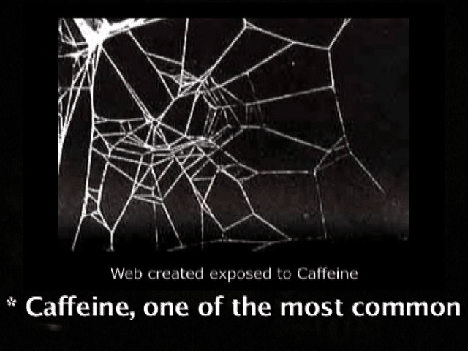
Web created exposed to Caffeine
Web created exposed to Benzedrine/Speed
Web created exposed to Chloral Hydrat (sleeping pills)
Now, one possible question here is: Is a system equivalent to a drug? In other words, can a social system influence the type of, let's say, architecture that we build? The type of works in general that we create? Of course! W/ this in mind, I ask YOU:
What system have I been using to construct this lecture?
[wait for answers & speculations from students & engage in discussion - the rough answer, to be modified based on the details of the moment, is what follows:]
Basically, my system, since I started on this insect tangent, has been to follow my inspiration in a flexible meandering way thru web searches & sources w/ a mind to eventually leading back to an obvious connection to the Systems subject at hand. This could be considered a Complex Adaptive System insofar as I responded to real-time stimulus (my inspiration) to determine my direction (my navigation of the web) & applied what I learned (from the "revision of the scout-recruit concept") to help me develop the tangent & to narrow down the focus from social insects (ants) into a non-social insect example (spiders) to enable the use of easily-related-to imagery (the pictures of webs made under the influence of drugs) to eventually evolve the idea of a System as potentially equivalent to a drug & to, therefore, bring the evolved & adapted idea of the system back not so much "full-circle" but full-spiral into an expanded & more complexly associated notion.
[show Four Organs cover here]
Onto music: Steve Reich is a well-known "Minimalist" composer. In the liner notes to the Angel recording of his 1970 piece "Four Organs" he wrote:
"Four Organs [..] begins w/ a short pulsing chord wch gradually gets longer and longer in duration. As the chord stretches out, slowly resolving and unresolving, a sort of slow-motion music is created."
"Four Organs is an example of music that is a "gradual process.""
"Performing and listening to a gradual musical process resembles: pulling back a swing, releasing it, and observing it gradually come to rest... turning over an hour glass and watching the sand slowly run through to the bottom..."
[play an excerpt from "Four Organs" here: 1:53]
[show Great Western Salt Works cover here]
Jack Burnham, in his 1968 essay entitled "Systems Esthetics", wrote:
"The kind of product design that once produced "better living" precipitates vast crises in human ecology in the 1960s. A striking parallel exists between the "new" car of the automobile stylist and the syndrome of formalist invention in art, where "discoveries" are made through visual manipulation. Increasingly "products" - either in art or life - become irrelevant and a different set of needs arise: these revolve around such concerns as maintaining the biological livability of the Earth, producing more accurate models of social interaction, understanding the growing symbiosis in man-machine relationships, establishing priorities for the usage and conservation of natural resources, and defining alternate patterns of education, productivity, and leisure. In the past our technologically-conceived artifacts structured living patterns. We are now in transition from an object-oriented to a systems-oriented culture. Here change emanates not from things, but from the way things are done.
"The priorities of the present age revolve around the problems of organization. A systems viewpoint is focused on the creation of stable, on-going relationships between organic and non-organic systems, be these neighborhoods, industrial complexes, farms, transportation systems, information centers, recreation centers, or any of the other matrixes of human activity. All living situations must be treated in the context of a systems hierarchy of values."
Both Reich's early works & Burnham's essays were of substantial interest to me when I was in my twenties. My own emphasis has often been on not producing 'precious' objects by producing multiples instead & on producing states-of-mind thru experiences - often w/ a political subtext meant to resystematize behavior in a more egalitarian way than more 'precious' culture had previously allowed for.
Even though I don't think that there's anything intrinsically egalitarian in systems thinking, I do agree w/ Burnham that thinking in terms of systems is more likely to involve the "larger picture" than most object-producing mindsets do. At any rate, it's interesting to me that Burnham connects Systems Art to ecological concerns.
[show Come Out cover here]
A not completely oblique reconnection to Reich's work is thru his 1966 tape piece "Come Out". As Reich explains in his liner notes for the Odyssey record version:
""Come Out was composed as part of a benefit, presented at Town Hall in April, 1966, for the re-trial, w/ lawyers of their own choosing, of the six boys arrested for murder during the Harlem riots of 1964. The voice is that of Danniel Hamm, then nineteen, describing a beating he took in the Harlem 28th precinct. The police were about to take the boys out to be 'cleaned up' and were only taking those who were visibly bleeding. Since Hamm had no actual open bleeding, he proceeded to squeeze open a bruise on his leg so that he would be taken to the hospital - 'I had to, like, open the bruise up and let some of the bruise blood come out to show them.'
""The phrase 'come out to show them' was recorded on both channels, first in unison and then w/ channel 2 slowly beginning to move ahead. As the phase begins to shift, a gradually increasing reverberation is heard wch slowly passes into a sort of canon or round. Eventually the two voices divide into four and then eight."""
One of the things that interests me about "Come Out" is that it's both process-oriented & political - even though I don't really consider it an example of the implied social-consciousness in Burnham's systems thinking, I still like the parallel. Here's the beginning of the composition:
[play "Come Out" excerpt here: 1:40]
Another quasi-relevant tangent is that of audio recycling. To me, what's most important about recycling is the reuse of physical materials in an attempt to not deplete natural resources. However, there's also the recycling of music, for example, as both homage & a building upon the initial musical form - or, as a subversion of it.
[show Reich Remixed cover here]
Reich's "Come Out" specifically, & the rhythms & so-called 'new tonality' in general of minimalist music have been an inspiration to more recent electronica & DJ culture. In the Reich Remixed double-record set from 1998 both Megamix & Ken Ishii used "Come Out" as basic material. Here's the beginning of Ishii's piece:
[play "Come Out remix" excerpt here: 1:02]
This type of recycling plays into the "transition from an object-oriented to a systems-oriented culture" that Burnham postulated insofar as the object is less important than the multitude of uses that the concept generates. The process is this: Danniel Hamm is recorded talking about being beaten by the police, Reich finds this experience worth educating the public about & takes a fragment of the recording to create a formally compelling piece to call attention to Hamm's dilemma, future musicians find Reich's piece compelling enuf to recreate it to both advance Reich's technique & to remind people that police brutality is still a problem. The system of communication & its message is what's important - not necessarily the object - especially given that the object is mass-produced & that its content can be played, such as in situations like this or via the radio or podcasts or whatnot.
[approximately 40 minutes at this point]
Perhaps my own personal favorite type of Complex Adaptive System might be what's sometimes called "Structured Improvisation". This is a way of improvising in wch some elements are predetermined as guidelines. My use of such structuring is to try to catalyze improvising outside the habitual patterns of the participant by imposing unusual procedures.
[show Official Wafer Face cover here]
Pictured here is the front cover of "The Official Wafer Face Record", released in 1993 by Wafer Face Records. This was a project founded by myself & instrument inventor/builder Neil Feather. We changed its name every time we played - usually in accordance w/ a formula that began w/ "The Official" & had the date in there somewhere. For simplicity's sake the generic name was "The Official Project" or "The Official Big Band" when the group was larger. This LP came w/ a booklet entitled "MORE INFORMATION than most people are likely to want to read".
[show MORE INFORMATION booklet cover here]
In this booklet many aspects of the Official Project are described in substantial detail - hence the title.
[show Some Social Philosophy section here]
In the "Some Social Philosophy" section, I try to establish a politicized take on systems of audience/performer relationships:
[show 2nd & 3rd paragraphs of the above here]
"Sometimes a structure of some playing is oriented around merging the audience & the players by having everyone present be both. So-called "improvisation" is often perceived as pointing in this direction insofar as whatever skills any player brings to the moment are often stressed as being at least as important if not more so than the skills originating from a directing person or group. In contrast, some bands just want to move the audience to support their egos & their bank accounts - often by using sado-masochistic psychology to "keep the audience in their place" - meaning to keep the audience thinking that any desire to break out of their fixed role is foolish b/c they "just don't have what it takes" to be "talented", entertaining, stimulating, "what-have-you". To the anarchistically minded, such greedy sado-masochistic manipulation of the audience into being victims rather than friends is a microcosm of the state's suppression of the individual.
"The more widespread the infrastructure/belief system that the masses are an untalented glop (of course, "the masses" may definitionally be "an untalented glop") turning to an elite (the band, the state) for guidance (entertainment/propaganda, laws), the fewer individuals there'll be willing to try to appreciate & respond to something that falls outside of the dominant structure. Of course, this is a "What came 1st, the chicken or the egg?) (all over your face) dilemma insofar as it can obviously be argued that "the masses" created the state in their/its own image & not vice-versa. Whatever. We don't solve these problems but we do (sortof) address them."
Given such philosophizing, it's no surprise that we supported the Friendly Fascist candidate Vermin Supreme in his bid for whatever:
[screen "The Official,
October 18th, 1991E.V.
Vermin Supreme for Mayor
Sound Assault Committee" excerpt here: 3:57]
I'll return to Vermin Supreme later. In the meantime, "The Structure of Our Playing":
[show The Structure of Our Playing section here]
Here's where words like "structure" & "system" become ambiguously interchangeable (as if that hasn't happened already?). Could the heading of this section be just as accurately entitled "The System of Our Playing"? Whatever. Here's the 1st paragraph:
[show the 1st paragraph of the above here]
"We primarily play what we call CAMUs. CAMU is an acronymn for Cue Activated Modular Unit. CAMUs are categories. CAMUs are generally unusual restrictions on playing wch are meant to discipline the player, focus the player's attention, unify the group's playing in some self-conscious way, & stimulate ways of playing that the player might not be ordinarily inclined to. These CAMUs are Modular Units b/c they can be used at (almost) any point in the playing - they're Cue Activated b/c the playing of them is initiated by certain signals. CAMUs can be triggered by (almost) any player at their discretion. CAMUs are conceptual building blocks, elements of a common language "open" enough to give the player satisfactory (hopefully) leeway & "closed" enough to provide a framework for intentional coherence."
[show "Mouthing off Intro" score outline here]
The image showing is the score outline for the beginning of a presentation by "the Official, April 29th, 1992E.V., Band that does Accept Money from Institutions". The brief movie that follows presents the realization of the 1st 3 parts of this score.
[screen "the Official, April 29th, 1992E.V.,
Band that does Accept Money from Institutions" excerpt here: 6:08]
3 CAMUs were presented in this example. The 1st, "Neuro-Linguistic Programming Intro" had the band name embedded in an extemporized rambling monolog. The 2nd, "Simon", is a classic child's game that exemplifies, for me, the use of structured improvisation as a stimulus to creative thinking. The 3rd, "Direct Mail (Ordinary 78 variation)", slots the instruction text into another CAMU to frame the presentation of the words. All 3 use systematic processes to generate unusual language use.
[show HiTEC logo ["BRAINLAYOUT2.jpg"] here]
Jump cut / Flash forward ahead 16 years: In mid-2008, I founded HiTEC - an acronym for Histrionic Thought Experiment Cooperative. The most "HiTEC" thing I can think of is the mind & that's one of the things that the name refers to - I'm not trying to sell the latest gadget. Since I'd previously worked w/ a substantial group of people in the Official Project, as many as 17 in one session, I wanted to try working w/ an even bigger group in HiTEC. The largest size the group's attained is 23 but only 21 have ever played together at once. I also didn't want to repeat the particular type of structured improvising that characterized the Official Project. As such, I wanted to mostly stay away from specific physical instructions & explore the parallel territory of what I prefer to call "thought experiments".
[show Systems Manager logo ["SysManLayout.jpg"] here]
Now we're getting somewhere! HiTEC performs a piece entitled "Systems Management". As such, the HiTEC members are called "Systems Managers" & I prefer to say that when we're performing we're "Managing the Systems". Such specificity of language is intended to foster a particular mindset. Each of the Systems in Systems Management is meant to be a thought experiment. Rather than perform specific physical actions in sync, the HiTEC Systems Managers attempt to THINK about the same conundrums [1 : a riddle whose answer is or involves a pun
2 a : a question or problem having only a conjectural answer b : an intricate and difficult problem] at the same time & to simultaneously try to somehow make physical something related to their thoughts. The language is all deliberately dry & businesslike - partially just in an attempt to avoid clichés of what many people think of as being so-called 'poetic'.
Each of the Systems in Systems Management has a number or not. A Wheel-of-Fortune is spun, that lands on a number, & that instigates a process determining what the Systems Managers then think about & attempt to actualize. The Systems w/out numbers are introduced thru spontaneous Systems Manager choice. It's my intention to try out something like this in this class. But, 1st, I'll play a few examples for you from 2 HiTEC rehearsals, our public premier at the New Hazlett Theater on January 9th, 2009, & our 2nd public event as part of the "The End of Television" at the Nerve Gallery on June 12th, 2009.
The 1st movie begins midway thru a realization of a thought experiment System called "Tele-Communications". You'll see the Wheel-of-Fortune to the right of the opening shot. August 28th, 2008 - this was the 15th rehearsal of HiTEC overall but this particular small group of Systems Managers were mostly just rehearsing for the 2nd or 3rd time. The crawling text at the bottom gives the System instruction. The basic idea of "Tele-Communications" is to try to get the other Managers to do something specific in some spontaneous way w/out using words. After "Tele-Communications" ends, the Managers "Debrief" & explain to each other what they were thinking & attempting to do. While witnessing the footage, pay particular attention to hand-signals & interactions. While everyone is playing an instrument, instruments aren't necessary. Systems Managers can use other means of making their thoughts physical.
[screen "HiTEC015-Tele-Communications" here: 5:40]
A little over 3 months later & we're at the 44th overall rehearsal on December 1st, 2008. I've done a superficial search on the internet for "thought experiments" & created 2 Systems based on 2 famous examples. One of these is called "Brain-In-A-Vat". The 1st 2 Wikipedia paragraphs on this subject read as follows:
"In philosophy, the brain in a vat is an element used in a variety of thought experiments intended to draw out certain features of our ideas of knowledge, reality, truth, mind, and meaning. It is drawn from the idea, common to many science fiction stories, that a mad scientist might remove a person's brain from the body, suspend it in a vat of life-sustaining liquid, and connect its neurons by wires to a supercomputer wch would provide it w/ electrical impulses identical to those the brain normally receives. According to such stories, the computer would then be simulating a simulated reality (including appropriate responses to the brain's own output) and the person w/ the "disembodied" brain would continue to have perfectly normal conscious experiences w/out these being related to objects or events in the real world.
"The simplest use of brain-in-a-vat scenarios is as an argument for philosophical skepticism and Solipsism. A simple version of this runs as follows: Since the brain in a vat gives and receives the exact same impulses as it would if it were in a skull, and since these are its only way of interacting w/ its environment, then it is not possible to tell, from the perspective of that brain, whether it is in a skull or a vat. Yet in the first case most of the person's beliefs may be true (if he believes, say, that he is walking down the street, or eating ice-cream); in the latter case they are false. Since, the argument says, you cannot know whether you are a brain in a vat, then you cannot know whether most of your beliefs might be completely false. Since, in principle, it is impossible to rule out your being a brain in a vat, you cannot have good grounds for believing any of the things you believe; you certainly cannot know them."
Turning this into a System means that the Systems Managers are asked to "Decide that you're a brain-in-a-vat instead of a brain-in-a-skull & that yr perceptions of what's happening in the current Systems Management session are programmed perceptions rather than 'real' ones. Adapt yr Management to what you then think is the most likely 'reality'." This is, of course, quite a challenge when taken seriously. How does a person do this? Here's some footage from the 44th rehearsal where the Managers try it & then debrief, as usual, afterwards.
[screen "HiTEC044-Brain-In-A-Vat" here: 6:50]
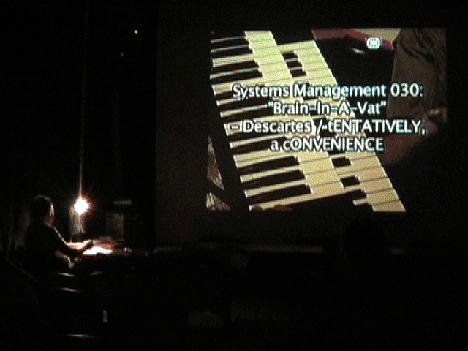
Of course, being silly also has alotof potential. Being thoughtful & active & imaginative & sensitive to each other & true to one's own personality is ultimately what these thought experiments in Systems Management are trying to stimulate. You may be sick of this somewhat haphazardly shot rehearsal footage by now so I'll give you another example of "Brain-In-A-Vat" combined w/ 2 other Systems as presented at the New Hazlett Theater. This is an example of what we were ultimately working toward & is much more sophisticated in its documentation.
[screen "HiTEC051-Concerto+Brain+Debriefing" here: 3:45]
Perhaps the most significant relevant part of the latter example in relation to the "Brain-In-A-Vat" thought experiment is the part where I imagine myself to actually be a brain-in-a-vat & then try to effect my imagined physical environment by producing waves to make the vat fluid slosh around - thereby using one of the isolated brain's only obvious aggressively physical characteristics, the ability to generate waves, to influence its surrounding environment. This, in turn, effects the editing choice - wch uses a wave effect to create visuals that would be otherwise unnatural in 'consensus reality' as I commonly 'understand' it.
[show HiTEC book cover here]
By the way, the local publisher, Encyclopedia Destructica, publishes a HiTEC book that also comes w/ a CD & the DVD from wch that last excerpt was taken - in case any of you want to research this further.
Given that this class is not a music class, I want you to understand that the Systems presented here don't have to have so-called 'musical' realizations. Any person being creative can use any medium to try to manifest their thoughts. Some of the Systems encourage a broader variety of behaviors than others. There's one called "Getting It Our Of Your" wch has the instruction:
"Become VERY DRAMATIC. EG: Tear yr clothes, play w/ extreme dynamic level differences, make huge sweeping gestures, weep & laugh copiously, act out secret fantasies, etc. In general, up the histrionics level as uninhibitedly as you can. Feel free to be a total embarrassment."
The next clip, from the "The End of Television"/HiTEC059 event can give you an idea of how that can be realized.
[screen "HiTEC059-Getting It Out of Your" here: 2:23]
Finally, here's an example of "Tele-Communications" in action again, again from our 59th manifestation, where the Systems Managers explore a fairly broad variety of actions. Added to this is a simultaneous realization of Ben Opie's MUTE OBSERVER System in wch a Manager sets off a chain reaction of silent observations that gradually lessens the amount of people making sounds. See if you can see this happening & if you can follow the Tele-Communications signaling.
[screen "HiTEC059-Tele+MUTE" here: 4:50]
For now, that's enough about HiTEC & Systems Management. At our next class together, we'll be trying out some of these thought experiment Systems & you'll be asked to create some of your own. One aspect of HiTEC & Systems Management that's probably not very immediately apparent is that it's an experiment in creating & enacting a consensus social system in wch individualism is encouraged. This is, inevitably, political in the sense that participation in the Systems Management is somewhat deterministic of how one governs one's self.
& that brings me back to the earlier thread of political systems in general & my assertion that no political system can ever be beneficial for everyone - they can only work toward that direction. As much as I dislike the use of dichotomies as descriptive devices, especially of complex systems such as socio-political ones, recent events have gotten me to thinking along such lines.
As you might surmise, the recent event in question is the G20. I see the G20 as being of no benefit whatsoever to the majority of the people both in the world & in Pittsburgh. I see it mainly as an opportunity for arms dealers to spread extreme paranoia thru the mass media, especially thru so-called tv 'news', so that they can make massive sales to both the police & to the paranoid citizen. I see it as an excuse to conduct military-style war games against the general population & as an opportunity for greedy & power-hungry politicians to advance their career path by showing that they'll go along w/ ANY oppressive program as long as it makes them more rich & powerful.
But regarding polarities, I see the G20's surrounding events as being most striking, if only b/c of the bluntness of the reduction I'm about to use, as an exemplification of DRACONIAN LAW vs CREATIVITY. By this I mean that the G20's invading & occupying army represented the System based on the belief that the LAW IS ALWAYS RIGHT - regardless of how clearly demonstrable it is to be unfair, unethical, & vicious. Furthermore, I mean that the forces that the occupying army tried to terrorize & suppress are what the 'law' is most afraid of: namely, the forces of creativity. My assertion is that creativity represents the archetype of a CAS, a complex adaptive system, b/c creativity is at its peak when it's the most flexible & the most adaptive. The so-called 'law', on the other hand, is at its peak when it suppresses any change that isn't top-down dictated.
As such, it's no coincidence that on the Sunday before the G20, September 19th, 2009, the invading & occupying army produced a massive show of terroristic force by raiding only the homes & studios of creative people in the name of ferreting out potential 'terrorist' threats.
Namely, there were 2 raids that night on the studio of "Artful Trash Management" sculptor & eco-philosopher Bob Johnson's studio. Bob was housing the Seeds of Peace free food providers. Bob is most well known for fishing trash out of rivers & having the trash compacted into cubes that he then exhibits as Rivercube sculptures. His studio was raided by 2 separate armies of highly armed & armored paranoid so-called 'law' enforcement people. They discovered nothing illegal.
The "The Nerve" Gallery's building was broken into by the police that night. The Nerve itself, where HiTEC's "End of Television" performance happened, was apparently not broken into but parts of the rest of the building, used as practice space for one or more bands around town, was. When the cops left, they left the building unlocked. When the owner discovered this the next morning, he was apparently confused about why the burglar alarm wasn't working. The cops discovered nothing illegal. Probably the main illegality was the police's own breaking & entering & the leaving of the space vulnerable.
The "Cyberpunk Apocalypse" house in Lawrenceville was raided by another small army of highly armed & armored cops. This is a writer's collective. As I understand it, the cops didn't even enter the house. This was, again, apparently mainly a terroristic show of force.
Around this same time, cops harassed other creative people potentially associated w/ political activism by driving past their houses & shining lights in their windows. This happened to friends of mine in punk bands & to a friend of mine who's an extremely dedicated prison activist & performer. Even a guy who rides a recumbent bike had his house raided. In all cases, the excuses for the raids were extremely flimsy & no evidence of criminal activities were found.
Perhaps 2 days later, the studio of the Zany Umbrella Circus was forced into by the cops & searched. Zany Umbrella has performed widely, including at the 3 Rivers Arts Festival. As usual, no criminal or so-called 'terroristic' evidence was found.
Creative people are obviously different from uncreative people. Creative social scenes are going to have creative behavior. They're going to have creative dressing, creative sex, creative lifestyles in general. & this makes creative people often easy to distinguish from the more common non-creative people &, as such, easy to scapegoat for nefarious purposes. On the flip-side, of course, creative people provide entertainment & stimulation services for the non-creative & are often highly valued for this.
But for the purposes of the big business of arms dealing, spreading fear of creative people is good business. "Is there someone different from you in your neighborhood?", the police liason might say at a community meeting, "FEAR & REPORT THEM". Buy AK47s to so-called 'protect' yourself against them. Buy THREE LRADs (Long Range Acoustic Devices) to so-called 'protect' yourself against them. What on Earth is the City of Pittsburgh going to do w/ THREE of these damned things?! In Pittsburgh, no less - one of the most peaceful & pleasant places I've ever been. &, in the meantime, the city's closing down libraries. What a disgrace. Lest you think I exaggerate too much the spreading of fear & paranoia through the spreading of propaganda preliminary to the G20, here's a parody movie that CMU professor Rich Pell & I made together about this issue. Everything in it, except for the conclusion, is based on an actual event.
[screen "TV 'News' Commits Suicide" here: 6:09]
Are there any questions about this? Such as about what specific events are being parodied here?
[allow time for discussion & relevant anecdotes]
Now, back to my friend Vermin Supreme: He, too, was here for the G20 demonstrations. Vermin tries to be both an advanced example of a creative lifestyle AND a person who addresses the war between the creative lifestyle & the policing lifestyle. The following is some footage of him addressing the cops in downtown Pittsburgh during the permitted march on Friday, September 25th, 2009.
[screen "Vermin Addressing the Cops at the G20" here: :44]
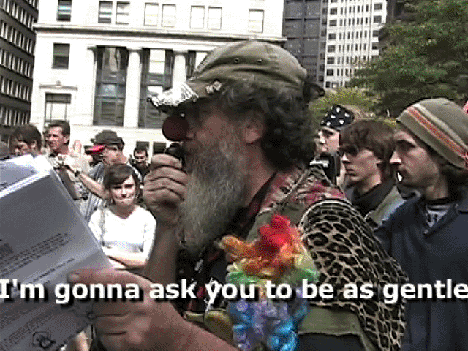
Finally, you may've noticed that there were many cameras
used for documenting the 2 HiTEC public events - 8 at the New Hazlett &
7 at The Nerve, to be specific. & another aspect of what I'm leading
up to here is the proposal that we thoroughly document what we do together.
How many people here have either cellphones w/ video camera capability or
video cameras in general? I propose that ALL of them be used somehow in
what we do together & that we all share the resultant files. THEN, if
nothing else, I'll edit together all the footage & make a DVD of the
result for everyone. Everyone else, of course, is welcome to do the same.
That's it for me for now - unless people have questions.
- recollections from tENTATIVELY, a cONVENIENCE
374. Systems & Processes 2: workshop
- CMU CFA, Pittsburgh, us@
- Monday, November 2, 2009
- I began by having the students realize the HiTEC (Histrionic Thought Experiment Cooperative) System named "Red Room":
01. "Red Room"(tENTATIVELY, a cONVENIENCE):
Each player chooses 2 units of sound as their only vocabulary. These units can be distinguished in any way. No unit can be played in approximately the same relational circumstance twice - ie: If player 1 plays unit 1 immediately following another player's unit 2 then player 1 must avoid having that sequence occur again. The player stops whenever they feel like it or when all such relational possibilities are exhausted.
Jon Rubin raised & lowered his drink bottle, a student put her elbows on the table, etc, as "units". This was followed by "Population Control":
09. "Population Control" (Johan Nystrom):
Only 1/5th of the Systems Managers shd play at one time (except that this number shd be no less than 2). Players shd try to accomplish this purely by paying attn to each other rather than thru hand-signals, glances, & other obvious means. EG: someone who's playing shd decide to drop out & someone who's not playing shd fill in the gap. If more than 1 player replaces 1 drop-out then an(other) player(s) shd also drop out to restabilize the relevant number. If too many players become active then some shd decide to stop on their own to correct this. This ends whenever other factors, such as a spin of the WoF, occur to interrupt it.
The students were in a circle around tables placed in a square. I projected the Systems Management instructions as slides, read the instructions & tried to clarify them. "Tele-Communications" came next:
10. "Tele-Communications"(tENTATIVELY, a cONVENIENCE):
Pick another player & attempt to communicate something that you want them to do to them w/o using words. You can either try 3 different ways of doing this or 3 different ways to clarify what you want. Continue playing if they eventually do what you want them to & stop playing for the rest of the system if they don't. As usual, various obvious complications will arise: EG: a Systems Manager might mime what they want the other player to do in such an obvious way that they make their chances of being able to continue substantial - or a Manager might want another player to do something that's highly likely to happen such as 'play something'. Contrarily, the "tele-communicator" might attempt to communicate in extremely subtle ways highly unlikely to be picked up by the targeted player.
One student made a dunking motion to which I responded with a dribbling one.
16. "IFF" (tENTATIVELY, a cONVENIENCE & Ben Opie):
"IFF" = "if & only if". Before any player plays they mentally create a condition external to themselves & their system wch has to be met for them to play. EG: Player 1 may decide in advance that they'll only play in a certain way for 10 seconds IFF Player 2 plays quietly by themselves for at least 5 seconds. Player 1 might also decide that they'll play in a different certain way IFF all players other than Player 2 play simultaneously. This creates the immediate problem of who plays 1st & under what conditions. Therefore, it's advisable that at least 1 player decides on an "IFF" that doesn't necessarily revolve around other people's playing - such as: "I'll play IFF an earthquake doesn't happen" or "I'll play IFF I'm taking the risk that it's highly likely everyone around me will play shortly after I start."
The students were eventually encouraged to develop their own systems. The class was divided into smaller groups called "Affinity Groups" (after political activist lingo used, in turn, by HiTEC). These groups were to brainstorm & to report back to the whole class. As I dimly recall, the students proposed some & we tried them. The results included "Robotic", "Object Exchange", "Expansive Gesture", & "Blinking":
"Robotic"
Systems Managers start from the perimeter of the space. Managers conceive of a robotic routine to perform & then follow it mindlessly. This usually involves moving away from the perimeter but doesn't necessarily have to.
"Object Exchange"
Systems Managers carry an object wch they handle in a way conventionally appropriate to that object. Managers then exchange objects w/ one another. Managers then use the new object in the same way that they used the original object. Each new object gets handled in the way that wd've been appropriate for the preceding object. EG: If a Manager starts w/ a squeeze toy & then trades that for woodblocks then the the Manager continues squeezing the woodblocks. THEN, if the Manager exchanges the woodblocks for a whistle, the Manager hits the whistle - as wd've been appropriate for the woodblocks, etc.. Sometimes the handling technique used will be coincidentally appropriate to the new object. EG: If in the above example a cymbal wd've been rc'vd instead of a whistle then hitting the cymbal wd've been coincidentally appropriate b/c woodblocks & cymbals are played using similar techniques. It's recommended that objects used for this be objects that can take some 'abuse' - IE: DO NOT USE YR EXPENSIVE INSTRUMENTS FOR THIS. If, by accident, an expensive &/or delicate object is used, PLEASE BE SENSITIVE & CONSIDERATE & HANDLE THE OBJECT CAREFULLY.
"Expansive Gesture"
Systems Managers begin by making an evocative gesture, such as yawning. Then, witnessing someone else's gesture, expand upon that. EG: A Systems Manager begins by scratching & sees another Manager yawn. The scratcher then lays down as if to sleep - as an extension of the yawning. If multiple Systems Managers are inspired by the same initiating gesture then whole strings of related gestures can happen. EG: While the scratcher is laying down, another Manager might respond to the yawn by slapping themselves in the face to 'try to make themselves wake up' while another might mime drinking a cup of coffee or another might play a lullaby, etc..
"Blinking"
Think of 3 things that you'll do when triggered to do so by another Systems Manager looking at you & blinking. A Manager can blink once, twice or 3 times. Once shd always trigger the same response in the receiving Manager, twice always another same response, & thrice always yet-another same response. EG: Manager A looks at Manager B & blinks once, Manager B then howls; Manager C then blinks twice at Manager A, Manager A then mutters to her or him self as if preoccupied; Manager B then blinks thrice at Manager A, Manager A then wiggles their fingers; Manager D then blinks once at Manager B, B then howls again, etc..
I, later, wrote the above encapsulations in order to facillitate future
Management of the Systems. Students were also asked to think of new Systems
for the next class.
- recollections from tENTATIVELY, a cONVENIENCE
375. Systems & Processes 3: workshop & guerrilla action
- CMU CFA, Pittsburgh, us@
- Wednesday, November 4, 2009
- I explained various percussion instruments to the class & demonstrated them - such as the thunder sheet, slap-stick, a-go-go, vibra-slap, triangle, Zydeco tie, tuning fork, rattles, tambourine, Chinese gong, ratchet, dog's squeeze toy in shape of human foot, dinner bells, bulb horns, cow bell, cymbals, bracelet bells, corrugated tubes, slide whistle, alarm whistle, siren whistle, kazoo, crow call, train whistle, boom whackers, small glockenspiel, colander, duck call, & flex-a-tone.
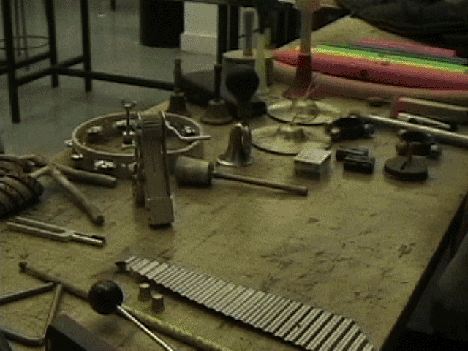
Assisting me were joy toujours playing violin, percussion, cordless drill, & cameras + Josh Beyer playing cello, percussion, & camcorder + Hyla Willis playing erhu, percussion, & cameras. A highlight of this event was probably when Hyla demonstrated the erhu & allowed some students to play it.
I explained the desirability of the use of multiple cameras & encouraged footage sharing so that we cd all work w/ a collective pool of footage. As it turned out, I did get footage from multiple cameras but no-one else seemed interested in working w/ these multiple sources.
Attendance to the class was poor & only a few of the students seem to've thought of new Systems since the last class. One of the students proposed a System based on the rules of "Fight Club". I explained that the idea for the Systems was meant to be based around how one THINKS about what one's doing rather than specific physical instructions. One of these few students proposed an "Imitation" System, another proposed a "Not Really" System, another "Pretend to be Someone". Another student who hadn't attended the last class admitted that she had "no idea what we're doing". [Uh.. I reckon that's why attending class might be a good idea, eh?!]
I attempted to clarify the difference between a Thought Experiment & specific physical instructions to the class by explaining Avicenna's "Floating Man" & explaining HiTEC's adaption of that as "Avicenna's Floating Systems Manager". Hyla, Josh, & joy then went on to try to explain their own takes on the matter.
From there we tried "Not Really" (not really called that) in which the Systems Managers were to perform a vocal sound as response to someone's miming cue. "Imitation" followed, "Pretending to be Someone" was rejected by the student who proposed it, then "Survival of the Fittest" was proposed: A person plays a rhythm & becomes the fittest when either they're the only person left playing their rhythm or when only their rhythm, played by others too, is being played. This was criticized on the basis of various criteria such as: the simplest medium-tempo pulse will probably win. Josh played pizzacato cello during this one.
We then tried "Robotic" which was the student System that I thought most successfully was a Thought Experiment.

"Robotic"
Systems Managers start from the perimeter of the space. Managers conceive of a robotic routine to perform & then follow it mindlessly. This usually involves moving away from the perimeter but doesn't necessarily have to.
I found this to be particularly successful exercise! One student sat cross-legged on the floor & banged an inverted stool seat on the floor, another walked around holding onto objects such as seats, table & tripod legs, etc.. One walked & stopped & rattled a tambourine periodically, another rearranged object placement thru rotation, the professor made weather announcements. I made a multiple camera quasi-document which I then posted online:
http://www.youtube.com/watch?v=DkZjJ1ePIos
Partially since the author of "Object Exchange" wasn't there, the professor proposed that we modify it. I found this amusing & 'poetic justice'.
"Object Exchange"
Systems Managers carry an object wch they handle in a way conventionally appropriate to that object. Managers then exchange objects w/ one another. Managers then use the new object in the same way that they used the original object. Each new object gets handled in the way that wd've been appropriate for the preceding object. EG: If a Manager starts w/ a squeeze toy & then trades that for woodblocks then the the Manager continues squeezing the woodblocks. THEN, if the Manager exchanges the woodblocks for a whistle, the Manager hits the whistle - as wd've been appropriate for the woodblocks, etc.. Sometimes the handling technique used will be coincidentally appropriate to the new object. EG: If in the above example a cymbal wd've been rc'vd instead of a whistle then hitting the cymbal wd've been coincidentally appropriate b/c woodblocks & cymbals are played using similar techniques. It's recommended that objects used for this be objects that can take some 'abuse' - IE: DO NOT USE YR EXPENSIVE INSTRUMENTS FOR THIS. If, by accident, an expensive &/or delicate object is used, PLEASE BE SENSITIVE & CONSIDERATE & HANDLE THE OBJECT CAREFULLY.
In the documentary that I made just about this class, there's an explanatory title that says: "tENT exchanges the camcorder w/ Josh for Josh's rattle. Josh then manipulates the camera by shaking it as if it were a rattle." This amply illustrates the type of process that resulted from this System.
Using a preplanning order of Systems ("Robotic", "Blinking", "Expansive Gesture", "Object Exchange"), we went to the CMU Student Center for a guerrilla application of the Systems Management that the class had developed so far. This center is an open area with multiple couches where students typically sit & converse & use their laptops or whatever. As Hyla pointed out, this was an opportunity for the students in the class to take transgressive baby steps.
joy started by rubbing plants with his hand. Hyla walked carryting her erhu case & other baggage & touched her forehead to objects by bending to meet them. The same student who'd banged the stool on the floor in class now sat on the floor with her shoes on her hands & alternated hitting the floor with them. Another slunk around the columns & walls with his back to them. The students were discouraged from maming sounds until the end so their eccentric behaviors wouldn't be immediately obvious. However, sounds, mostly using my percussion instruments, were dominating by "Expansive Gesture". During this latter, I tried to set off s chain of yawns by yawning at fellow Systems Managers.
What either the participants or the unsuspecting student (v)audience
made of this is largely a mystery to me. Somewhat to the "Systems &
Processes" class participants' surprise, a group of girls not in the
class started practicing what appeared to be a cheerleading routine. This
was a marvelous coincidence. Given that I think that guerrilla actions are
far more important experiential learnings than classroom confinements, I
was happier with this. One student reported that someone came up to her
during "Expansive Gesture" (probably) & made a 'Hey' sign
to her so she took that as a cue to, in turn, do that to others. 2 students
also shared their footage with me.
- recollections from tENTATIVELY, a cONVENIENCE
376. Systems & Processes 4: workshop & guerrilla action
- CMU CFA, Pittsburgh, us@
- Monday, November 9, 2009
- This was the last of my "Systems & Processes" classes & the one where I felt things came together best. Assisting me once again was my good friend & fellow HiTEC member Hyla Willis (percussion, camcorder). Additionally, my other good friend & fellow HiTEC member Unfinished Symphonies (recorders, camcorder). Most or all 15 of the students attended this class - as opposed to only 6 of the 15 at the last class. The class more or less started off with one of the students proposing a System that I thought was one of the strongest ones:
"Numbers"
Systems Managers each pick a number from 1 to 9 & stick w/ that # for the duration of the realization of the piece. Managers call out their number at will. Each Manager then adds or subtracts in their head the 2 most recent numbers called out. If the resultant number is their prechosen number then they can move that number of steps in a straight line. Managers can choose to have addition be different from subtraction in terms of wch direction the resultant straight line can go. EG: Manager Z calls out "7",
Manager Y then calls out "4", all Managers then calculate that 7 + 4 = 11 & that 7 - 4 = 3. Since 11 is above the upper limit # of 9 it can't be any Manager's number &, therefore, noone can move as a result of addition. However, since 3 is w/in the "1 to 9" limit, it can be a Manager number. Let's say that four Managers have chosen "3" & that 1 of them has chosen to move right if their number is a result of subtraction. That Manager then moves right 3 steps. Let's further say that the remaining three Managers w/ the number "3" have decided to move either backwards or left if their number is reached thru subtraction. Then let's say that two of these three then take 3 steps backwards & the other takes 3 steps left. As w/ most Systems, if a Manager's predetermined personal System (ie: the number chosen & the particular response to the conditions of its production - ie: addition or subtraction) chooses to be unworkable (eg: immediately leads them to facing an obstacle that they can't get around) then that's what the Systems Manager is stuck w/! IE: There's no changing one's personal criteria 'mid-stream'.
While this wasn't, strictly speaking, a Thought Experiment, it did require a substantial amount of thinking prefiguring action. Of course, I also liked it because it involved basic math. We realized this one, discussed & clarified it, & tried it again.
We reviewed "Robotic", "Blinking", & "Object Exchange" & then realized the latter.

In keeping with my emphasis on multiple collaborative camera use there were at least 3 cameras quasi-documenting this. "Robotic", "Blinking", & "Expansive Gesture" followed (see the descriptions of the previous "Systems & Processess" classes).
We then moved to the CMU Student Center for another guerrilla realization of these Systems as we had in the last class. This time starting with "Numbers" in a more open area where there weren't couches.

In my quasi-documentary of this, I inserted the following crawl title during this section:
"For me, Managing this type of System stimulates interesting statistical &/or probability musings. Note that no-one has picked 1 or 9. Does this imply that their personal systems involve addition equalling forward motion & subtraction equalling backward motion? If so, then 1 cd only be reached by subtraction &, therefore, only yield backward motion - & 9 cd only be reached by addition &, therefore, only yield forward motion. Hence both numbers are less flexible than the rest. HOWEVER, since no-one picked them, 2 & 8 end up in the same situation. If everyone played it maximally safe & chose 5 then no-one wd be able to move b/c 5 cdn't be reached by either subtraction OR addition since all Systems Managers wd only be saying 5!"
"Blinking", "Object Exchange", "Robotic", & "Expansive Gesture" followed. We then decided to go thru the same process again at the tennis courts. On an adjacent court a tennis game was in progress. This was probably the point at which the students opened up the most - glad to be outside. There was more laughter & relaxed silliness within the otherwise somewhat rigorous framework. A trumpeter could be heard practicing in the distance.
We returned to the classroom for a summing-up discussion. One of the students who hadn't attended all of the classes asked: "What did we just do?" to which I laughed & replied something along the lines of "Basically it refers back to structured improvisation [..] as a Complex Adaptive System - &, for me, the purpose of things like this is to increase my ability to make real-time decisions & to increase my memory & to increase my spontaneity & increase my alertness, etc, etc - increase any kind of quality that has to do with my environment around me."
Unfinished Symphonies pointed out the value of breaking from one's routines as stimulation to step outside one's own limited habits as a creative activity. I asked the class if they'd at least had some fun to which there was a little bit of disappointingly half-hearted nodding. One of the students who had actually fallen asleep in class at one point (not necessarily from boredom - anemia & other problems occurred to me as explanations) revealed that she'd had what was for me the ideal reaction: namely inspiration & alertness as a result of the procedures. Another student, who I'd found to be particularly resistent at times, revealed that to him it was like experiencing child's games with adult experience.
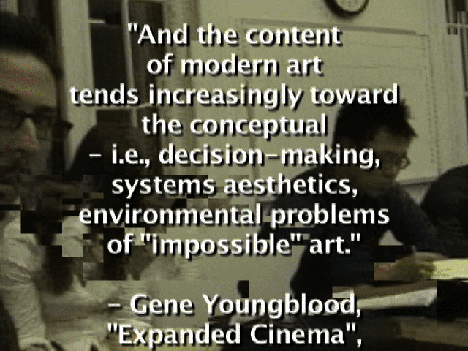
I'd promised the students that I'd make a documentary about these 4 classes
& get it to them ASAP. As such, I spent the next 3 (unpaid) weeks making
a packaged DVD & a packaged CD & I hand-delivered these to the professor
at the end of November a few hours before he was to reconvene with the class.
I later learned that he didn't give these to some of the students until
a few months later after the semester was over. I still don't know whether
all the students got theirs. I found this to be an unfortunate ending to
my very hard work.
- recollections from tENTATIVELY, a cONVENIENCE
to Personal Favorites: 1959-1989